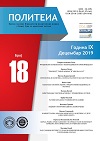Izgradnja sopstva kroz simboličku interakciju sa drugim u svakodnevnom životu
The Construction of the Self Through Symbolic Interaction With the Other in Everyday Life
Author(s): Ivan Šijaković, Dragana VilićSubject(s): Anthropology, Philosophy, Sociology
Published by: Fakultet političkih nauka Univerziteta u Banjoj Luci
Keywords: The Self; symbolic interactionism; communication; everyday life;
Summary/Abstract: In this paper, the authors try to test, with the help of other authors who have discussed this topic, first in terms of interpretive sociology and later within the framework of symbolic interactionism, how the self is formed. With regard to this, the self is viewed as the most important instrument of free communication and interaction in everyday relationship with the other, in which people adjust to each other and by which the subjective meanings of people’s behaviour are emphasised. In the first part of the paper, entitled ‘Understanding the meaning of human action within the framework of interpretive sociology’, the meaning of human action plays a central role, and the basic goal of sociological analysis is to understand, that is interpret the meaning. This part gives, in brief, the analysis of the meaning of human action through three perspectives within interpretive sociology: phenomenological sociology, ethno-methodology, and symbolic interactionism. In the second part of the paper, entitled ‘Symbolic interactionism: the symbolic meaning of the interaction of the self and the other in everyday life’, the ability of a human being to define and interpret mutual actions is analysed. Symbolic interactionism has its origins in the philosophical pragmatism and social behaviorism of George Herbert Mead. Interaction (face to face) takes its central place and the self is the key term. In Mead’s social construction of the self (‘I’ and ‘me’), interaction and communication are crucial (learning about the self through interaction with the other). According to Herbert Blumer, who formulated the phrase of symbolic interactionism, human society is the product of a specific human interaction mediated by the use of symbols. The third part of the paper, entitled ‘Erving Goffman’s ’dramaturgical model’ of studying social life and constituting the self’, analyses the so-called dramaturgical model of the study of social life - the face-to-face interaction between people in everyday encounters and the role of the self in it (the construction of the self), where an individual as an active and creative actor performs their (social) role in a particular social situation in front of others, coined by Erving Goffman using a metaphor of a theatre performance for everyday life.
Journal: Politeia - Naučni časopis Fakulteta političkih nauka u Banjoj Luci za društvena pitanja
- Issue Year: 9/2019
- Issue No: 17
- Page Range: 81-106
- Page Count: 26
- Language: Serbian

